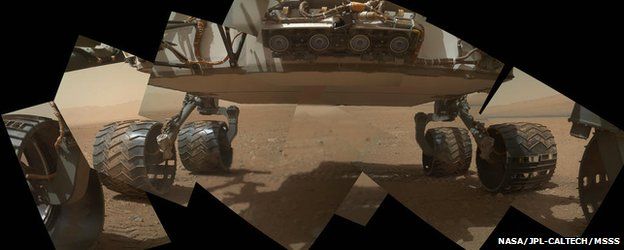Mars to Earth: How to send HD video between planets
- Published

"It once was a small step... now it's six big wheels," exclaimed Curiosity's Twitter account after the Nasa rover landed on Mars in early August.
The message itself took a fraction of a second to post on the social network.
But the media team at Nasa's Jet Propulsion Lab - who wrote it - had had to wait about a quarter of an hour for the signal sent by the vehicle confirming its touchdown to travel from the Red Planet to Earth via radio waves.
The time delay is a result of the fact that data cannot be sent back faster than the speed of light - real-time interplanetary conversations are the stuff of science-fiction fantasy.
However, efforts are underway to send more data at once by increasing the bandwidth available - to one day stream high-definition (HD) video from the surface of the planet.
While Curiosity was able to send back a small black-and-white image of its surroundings within a couple of minutes of its touchdown alert, Nasa's technology is still some way off from being able to provide a high-definition video stream of its activities.
But if efforts to switch from radio to laser-based systems bear fruit, future missions might not be bound by the same restriction.
Across space
Radio waves have a lower frequency than visible light, but belong to the same electromagnetic spectrum and can travel through space at the same speed: 300,000km per second (186,000 miles per second).
To send the rover daily instructions, Nasa uses direct-to-Earth transmissions, contacting Curiosity via the X-band segment of the radio region of the electromagnetic spectrum, portions of which are reserved for deep-space communications.
A different radio system is in play to beam full-colour photos back to JPL.
"The images are stored digitally on Curiosity's computer, [and then sent to] one of two Mars orbiters - Mars Odyssey and Mars Reconnaissance Orbiter (MRO) - that fly overhead in the mid- to late afternoon on Mars," explains Rob Manning, Curiosity project's chief engineer at JPL.
There is also a third, European, orbiter, called Mars Express, but it is usually used as a back-up for Nasa missions.
Once an orbiter receives the data, it beams it to large dish-shaped antennas of the Deep Space Network (DSN). There are three DSN stations around Earth - in Spain, Australia and California - and the data gets picked up by the antenna that is more "in line" with the orbiter sending it.
Odyssey sends the information at 256Kbps (kilobits per second) - much slower than MRO's rate of 2Mbps (megabits per second) at closest range which is comparable to the average broadband speed on Earth.
The signal has to travel millions of kilometres across space. The distance between Earth and Mars changes constantly because the two planets travel around the Sun at different speeds, and the average distance between them is 225 million km (140 million miles).
But at the shortest distance between the planets, it takes less than half an hour for the signal to get picked up by one of the DSN stations, says Mr Manning.
The information is then forwarded to Nasa.
The fastest time it takes for a high-resolution, colour image to arrive at Nasa from the moment it is snapped by the rover is about 30 minutes - but it may take up to several hours, he adds.
Light detectors
In the future it could become possible to send more data at a time between planets - and maybe even stream HD video.
Scientists at Massachusetts Institute of Technology (MIT) and JPL have been developing detectors able to sense laser signals in the infrared part of the optical spectrum - all the way down to the smallest unit of light, a photon.
Optical signals have a much shorter wavelength than radio frequency signals, which means much higher data rates.
A single photon-counting detector translates the arrival of a single photon into an electrical pulse, which is then processed to retrieve data.
"Optical communication for interplanetary missions will become operational next decade," says Stephen Townes, the manager of the communication technologies and standards office at JPL.
"It will not replace radio frequency communication anytime soon but will be an enhancement to our communication capabilities.
"We can get 10 times improvement in data rate by switching to optical.
"Nasa has plans for an operational 1Gbps (gigabit per second) optical capability from Mars orbiters at a nominal distance of 150 million km (93 million miles) in the next decade."
The US space agency aims to test the detectors in 2013, during the Lunar Laser Communication Demonstration experiment.
The technology will try to transfer data from the Moon to the Earth at a rate of 622Mbps - much faster than average broadband speed, but still slower than the fastest Earth networks that send data at speeds of 20Gbps and above.
For Mars, the detectors could increase the data transfer rate to 250Mbps by about 2018, says Mr Townes.
And if the next-generation rovers are set up to stream video, maybe one day viewers on Earth will get a much better sensation of what it is like to move around on the Red Planet.
- Published12 September 2012
- Published18 September 2012
- Published6 September 2012
- Published22 September 2012